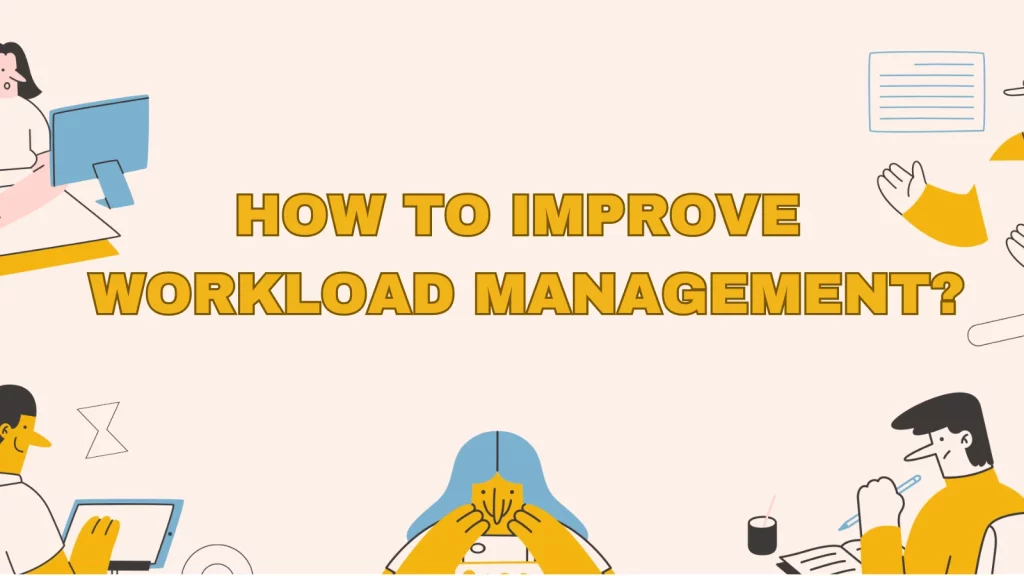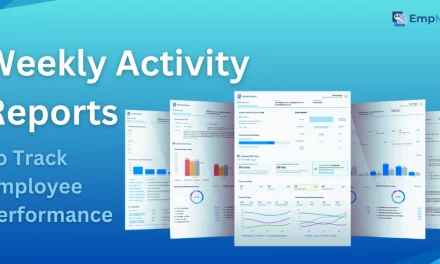Effective workload management is crucial for maintaining productivity and preventing burnout. Whether you juggle multiple projects, manage a team, or strive to balance personal and professional commitments, mastering the art of managing workload can transform chaos into order.
You can streamline workflows and ensure timely project completion by strategically prioritizing tasks, leveraging technology, and fostering efficient communication. This blog delves into practical tips, tools, and strategies to help you optimize your workload, enhance focus, and achieve a sustainable work-life balance.
Let’s explore the essentials of managing workload and empower you to take control of your time and productivity. So, without any delay, let’s get started!!
In a hurry? Listen to the blog instead!
What Is Workload Management?
Workload planning or management involves organizing and scheduling tasks and responsibilities and assigning them to individuals or teams to ensure efficient and timely completion. It includes assessing work volume and complexity, prioritizing tasks based on impact, and monitoring progress to maintain performance and prevent burnout.
Effective work management also considers team members’ capacity and skills to avoid overloading or underutilizing anyone, ultimately leading to optimal productivity and efficiency.
For example, the dashboard displays a team’s capacity and current workload, simplifying task management and reallocation. Imagine your design and advertising agency has four projects: brand identity creation, social media graphics, website design, and ad campaign visuals.
To manage your team’s workload:
- Assign specific tasks: Allocate tasks to your design team, clearly define schedules, and ensure manageable workloads for each project.
- Conduct regular check-ins: Hold daily or weekly meetings to monitor progress and ensure balanced workloads.
- Reallocate tasks as needed: If a designer finishes early on Project B, have them assist with Project A or contribute to Project C.
This approach ensures efficient use of resources and timely project completion.
Why is Workload Management Important?
Managing workload is crucial for organizations striving for operational efficiency and profitability. It involves strategically allocating and scheduling tasks to ensure work is completed efficiently, on time, and within budget. This process is essential for achieving business objectives and maintaining a healthy and productive work environment.
Realistic Work Plans
Managing workload helps in setting realistic expectations for project deliverables. By understanding the capacity and skills of the team, managers can create attainable work plans. Delivering on promises is core to maintaining client trust and satisfaction. Overpromising and underdelivering can damage client relationships and the organization’s reputation.
Minimized Delays and Disruptions
Proper workload management ensures that projects are more likely to be completed on time, reducing delays that can cost the organization financially and reputationally. Projects are more likely to stay within budget, boosting the organization’s financial performance by minimizing disruptions and ensuring smooth workflow.
Optimized Resource Allocation
Evenly distributing tasks among team members prevents burnout, and employee dissatisfaction and ensures you have used all resources effectively. Optimal use of resources means that the organization gets the best return on investment. Each team member’s time and skills are utilized to their fullest potential, contributing to overall productivity and profitability.
Increased Staff Satisfaction
An environment that challenges employees appropriately without overwhelming them fosters job satisfaction. Employees are more likely to feel valued and motivated when their workload is manageable. High staff satisfaction leads to lower turnover rates. Retaining skilled employees reduces the costs associated with hiring and training new staff.
Support for Retention and Recruitment
Effective workload management involves forecasting future workload demands and planning capacity accordingly. This readiness helps scale operations smoothly and meet future challenges. A well-managed workload makes the organization an attractive workplace, aiding in recruiting top talent and retaining existing employees.
Ethical Imperative
Managing workload is not just a business necessity but also an ethical obligation. Employers have a duty of care towards their employees to protect their physical, mental, and emotional health. Organizations can prevent employee burnout and the associated health risks by managing workloads effectively. It is vital in light of the risk of mortality.
Effective workload management ensures that employees are not among the alarming statistics of those suffering from the consequences of long hours and excessive stress. By fostering a supportive and balanced work environment, organizations can enhance productivity, protect their workforce, and achieve sustainable growth.
What Causes Workload Issues?
Employees often feel overwhelmed by heavy workloads due to various factors, which can be personal or related to management and organizational practices.
Unrealistic Expectations
Unrealistic expectations about what you can achieve within a specific timeframe are the common cause of workload issues. These expectations may arise from:
- Needs to be more accurate in the complexity and scope of tasks.
- Failing to recognize dependencies that could cause delays or additional work.
- Overestimating the confidence and competency of employees to complete tasks.
- Overestimating employees’ current capacity.
- Refrain from underestimating the impact of manual processes, poor systems, and administrative burdens.
Such misjudgments can lead to tasks taking longer than expected, creating backlogs and contributing to overwhelm and burnout. If not addressed, the workload accumulates, pushing unfinished work from one week into the next and exacerbating the problem.
Managers must understand the day-to-day realities of different roles to schedule work realistically. Time-tracking software like EmpMonitor can aid in setting accurate expectations by providing data on how long tasks take.
A Demanding Work Culture
Certain sectors are notorious for a culture that demands long hours. Workload Management and peer pressure might make employees believe their heavy workload is acceptable when it becomes normalized. Industries like consultancy firms and game development are known for tackling grueling overtime cultures and poor work-life balance.
Uneven Workload Distribution
An uneven distribution of work can be demoralizing, especially when some employees are overwhelmed while others lack sufficient tasks. It indicates a problem with workload distribution, which you need to address to ensure fair and balanced workloads.
Having In-Demand Expertise
Employees with specialist expertise often face heavy workloads due to their high-demand skills. Protecting these core individuals from burnout is crucial, as losing them to turnover or exhaustion can significantly impact the organization. Utilizing reports to identify high-demand roles and skills can help you plan and recruit additional resources.
Under-Resourcing
A lack of resources can make workloads unmanageable. Managers can manage temporary issues by reprioritizing tasks. However, long-term problems such as hiring freezes, recruitment challenges, or unexpected skills gaps require effective capacity planning to forecast and meet resource demands.
Poor Management
Inadequate workload management can lead to workload problems. Managers often get promoted without proper training, leaving them unprepared to lead. Investing in management training can help improve prioritization and support for staff, alleviating workload issues in specific teams.
Personality Traits
Some individuals are more prone to disorganization, procrastination, poor prioritization, and burnout. The WHO recognizes that personal factors can contribute to experiencing burnout. Managers must provide training and support to help such individuals overcome these challenges and thrive in their roles.
How to Improve Workload Management?
Effective management involves strategic steps to foster a positive work environment, enhance work quality, and promote work-life balance. These steps ensure that each team member contributes effectively without becoming overwhelmed.
Step1: Start with Selecting a Work Allocation Management Tool
A company with various departments and resources needs a cohesive system to assign tasks efficiently. When data scatters across multiple tools and apps, employees can waste valuable time tracking the necessary information, leading to delays.
All-in-one project management and resource scheduling tools, like EmpMonitor, can streamline work processes, optimize productivity, and simplify complex tasks. EmpMonitor is famous for its workforce management functionality, which helps in workforce management, tasks, and resource allocation.
Workload Management With EmpMonitor
EmpMonitor is a comprehensive employee monitoring software designed to enhance productivity and security within organizations. It offers a range of features that allow employers to track and manage employee activities, ensuring efficient use of time and resources.
Employee Activity Tracking
EmpMonitor provides real-time visibility into employee activities, showing which applications and websites employees use at any time. The software also takes periodic screenshots of employee screens, offering a visual record of their activities.
Application and Website Usage
The software logs the time spent on various applications and websites, helping employers understand which tools their employees use frequently. This feature ensures employees are not spending excessive time on non-work-related sites.
Productivity Analysis
EmpMonitor, a workload management tool generates detailed reports that provide insights into employee productivity, highlighting active, idle, and offline time. It assigns productivity scores based on activity, helping managers identify high and low performers.
Time Tracking
The workforce management software tracks the total hours worked by each employee, including start and end times, and records periods of inactivity, helping to distinguish between productive and unproductive time.
Keystroke Logging
The software records keystrokes, providing data on the content employees type. This feature is beneficial for detecting data breaches or unauthorized activities.
Data Security
EmpMonitor ensures that all monitoring data is securely stored and accessible only to authorized personnel. It also helps organizations comply with data protection regulations by providing tools to manage and secure employee data.
Remote Teamload Management
Employers can monitor and manage employee activities from anywhere useful for remote or distributed teams. Admins can remotely control certain aspects of employee systems, such as application blocking or web filtering.
Reporting and Analytics
The software offers customizable reporting options, allowing employers to generate reports focused on specific metrics or timeframes. Interactive dashboards provide data visual representation. It makes it easier to interpret and act upon insights.
EmpMonitor is a powerful and one of the best team workload management tools for organizations looking to improve efficiency, security, and workforce management. Its extensive features and customizable settings make it a versatile solution for various business needs.
Step 2: Create Tasks and Delegate Them Effectively
Break down projects into manageable tasks and subtasks using a work breakdown structure. Understanding team members’ strengths and weaknesses allows for effective task delegation, empowering them with responsibility and ownership. EmpMonitor’s real-time updates facilitate task management, ensuring everyone knows their responsibilities.
Step 3: Visualize Resources
Storing and visualizing project management resources in one location is crucial. EmpMonitor allows you to invite team members, specify their roles, set costs, and manage calendars. You can organize virtual and real resources, ensuring a clear overview of project requirements.
Step 4: Allocate Resources Properly
With a clear overview of tasks, you can assign the right team members to the appropriate activities. Workload management enables you to allocate resources, set priorities, estimate task durations, and track time. It ensures that you use resources efficiently and tasks get completed on schedule.
Step-5: Make Work Distribution Management a Must-Have Procedure
Clear visualization and continuous balancing of workloads are essential. It helps track resource workloads and makes it easier to adjust allocations and avoid underutilization or overloading. The platform allows for monitoring assignees’ availability, reassignment of tasks through drag-and-drop functionality, and managing personal calendars.
Step-6:Prioritize Team Collaboration
Effective collaboration is core to successful work management. Communicate with your team about resource reallocations to balance workloads. It facilitates collaboration through notifications, document sharing, file attachments, and real-time communication.
Step-7: Ensure Clarity and Healthy Workload Coordination
Workload management prevents burnout by maintaining clear communication and healthy workload coordination. Managers should lead by example, demonstrating a balanced approach to work. It includes avoiding overwork and ensuring team members understand the bigger picture and their roles in achieving project goals.
Step 8: Be Ready to Reassign and Make Changes
Work management requires adaptability. Monitor workloads, identify issues early, and make necessary adjustments to meet project goals. Continuous monitoring helps spot challenges and implement changes promptly to ensure project success.
These steps help you improve management, enhance team productivity, and achieve better project outcomes.
Read More
How To Manage Workload Planning In 7 Steps?
How To Streamline Your Personal Workload Management Process
9 Tempting Reasons To Invest In Workload Management Tools
Tips for Effective Workload Management
Managing the workload is daunting, especially when juggling multiple projects, deadlines, and team members. Without efficient strategies in place, it’s easy to become overwhelmed. To master this art, it’s essential to adopt effective techniques. Here are some tips to help you manage your workload efficiently:
1. Make Time to Plan
Planning is core in both personal and professional settings. Taking a step back to assess tasks and projects allows you to prioritize effectively. Estimate the time needed for each activity, set clear start and end dates, provide detailed descriptions, and categorize tasks accordingly. Cultivating a culture of planning enables you to create project timelines, monitor progress, and allocate resources efficiently.
2. Determine Resource Availability
Visibility of resource allocations is crucial for maximizing productivity and workload management. With multiple projects running concurrently, it can be challenging to manage resources effectively. Consider investing in a resource management application to get a clear view of resource availability. It allows for proactive planning and task allocation, ensuring that projects proceed smoothly even when new resources are unavailable.
3. Estimate Tasks and Set Realistic Deadlines
Task estimation helps in intelligent project planning and setting achievable deadlines. Understanding each team member’s pace enables you to allocate tasks appropriately. Realistic deadlines prevent projects from lingering unfinished, providing better visibility and control over workflow. It ensures that team members are neither overburdened nor underutilized.
4. Create a Capacity Plan
Overburdened employees are less effective. Effective workload management and distribution help identify when additional support is needed. Maintaining a healthy work-life balance for the team is crucial to prevent burnout. Research has shown that employees struggle to set limits, often feeling obligated to respond to emails outside of office hours. Creating a capacity plan ensures that workloads are manageable and sustainable.
5. Identify Task Dependencies
Project management is akin to solving a complex puzzle, where every task is interconnected. Understanding task dependencies helps identify potential roadblocks and ensures smooth project execution. By setting dependencies, you can proactively address issues that may impact project timelines, ensuring efficient workflow management.
By implementing these strategies, you can effectively manage your workload, optimize resource utilization, and promote a productive work environment.
The Bottom Line
Effective workload management is crucial for maintaining productivity and preventing burnout in any organization. Employers and managers can streamline their workflows and achieve better results by implementing tips as mentioned above.
Leveraging workload management tools like EmpMonitor can further enhance visibility into resource utilization and task progress, ensuring efficient management practices. Prioritizing work-life balance and fostering open communication remain integral for sustaining productivity and team morale.
With the right tools and practices, work management becomes a cornerstone of success in today’s fast-paced work environments.
FAQs
What are the 5 steps of proper workload management?
Here are the steps:
Assess Workload: Understand team capacity and current tasks.
Allocate Tasks: Divide work based on skills and availability.
Monitor and Adjust: Regularly check progress and adjust assignments.
Boost Efficiency: Implement strategies to improve productivity.
Use Tools: Utilize work management tools for organization and collaboration.
Is there a difference between workload management and time management?
Workload management focuses on balancing the quantity and complexity of tasks assigned to individuals or teams, while time management is about maximizing the efficient use of time to complete those tasks within deadlines.
What are the 4 D’s of Workload Management?
The 4 Ds are: Do, Defer (Delay), Delegate, and Delete (Drop). Categorizing tasks or projects into these groups helps you manage your limited time more effectively and stay focused on what matters most.
















